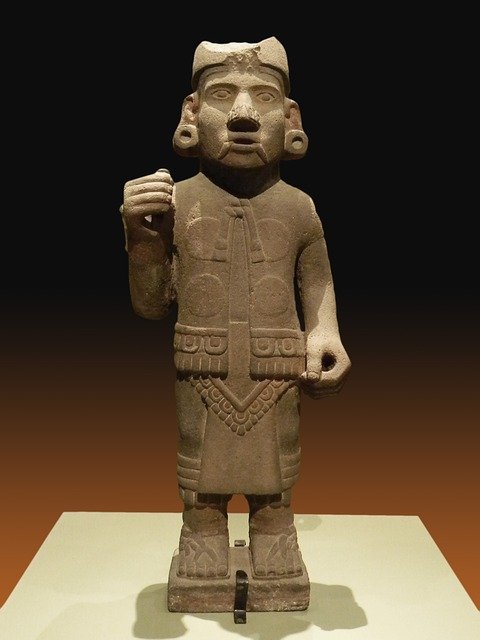
सिन्धु सभ्यता में जीवन || Life in indus civilization
Harappai (Sindhu) script - The Harappan script is found on the rectangular seals of Salkakhri , copper pellets etc. About 64 original symbols have been received in this script. The earliest specimen of this script was obtained in 1853 AD. A few years later, by 1923, the entire script had come to light. The script was pictograph ie pictorial . This script is written from right to left. The most pictures are of 'U' size and 'fish' . This script has not yet been read.
हड़प्पा का धार्मिक जीवन – इस सभ्यता में रहने वाले निवासी ईश्वर की पूजा किया करते थे। वे लोग भूत - प्रेत तंत्र-मंत्र आदि में विश्वास किया करते थे। यह अनुमान ताबीजों के प्राप्त होने से लगाया गया। इसके अतिरिक्त मुहरों पर बली प्रथा के दृश्य अंकित मिले हैं, जिससे बली प्रथा का अनुमान लग जाता है। हड़प्पा के लोग मातृदेवी, रुद्र देवी आदि की पूजा किया करते थे। इसके अतिरिक्त वृक्ष, पशु, साँप, पक्षी आदि की पूजा होती थी। ये लोग पुनर्जन्म में विश्वास रखते थे। मोहनजोदड़ो से प्राप्त विशाल स्ननागार का प्रयोग धार्मिक अनुष्ठान आदि में किया जाता होगा। कालीबंगा नामक स्थान से अग्निकुंड के साक्ष्य के आधार पर अनुमान लगाया जा सकता कि अग्नि तथा स्वास्तिक आदि की पूजा की जाती रही होगी। स्वास्तिक और चक्र सूर्य पूजा के प्रतिक माने जाते थे। सभ्यता के निवासी मृत्यु के बाद दाह संस्कार के 3 तरीके अपनाते थे - पूर्ण शवाधान, आंशिक शवाधान एवं कलश शवाधान। इन लोगों के धार्मिक दृष्टिकोण का इहलौकिक और व्यावहारिक था। मूर्ति की पूजा का प्रारंभ शायद सिंधु सभ्यता से ही हुआ होगा।
Religious Life of Harappa - Residents of this civilization used to worship God. They believed in ghosts - phantom tantra-mantras etc. This estimate was derived from the receipt of amulets. In addition, seals have visible scenes of the bali system, which leads to the estimation of the bali system. The people of Harappa used to worship Matri Devi, Rudra Devi etc. Apart from this, trees, animals, snakes, birds etc. were worshiped. These people believed in rebirth. The huge Snnagara derived from Mohenjodaro must have been used in religious rituals etc. On the basis of the evidence of Agnikund from a place called Kalibanga, it can be inferred that Agni and Swastik etc. would have been worshiped. Swastikas and Chakras were considered to be a symbol of Sun worship. Residents of the civilization used 3 cremation methods after death - full cremation, partial cremation and urn cremation. The religious outlook of these people was peculiar and practical. The worship of the idol may have started from the Indus civilization itself.
आर्थिक जीवन – इस सभ्यता की उन्नति प्रमुख कारण उन्नत कृषि एवं व्यापार था। इस काल की अर्थव्यवस्था सिंचित कृषि अधिशेष, पशुपालन, विभिन्न दस्तकारों में दक्षता तथा समृद्ध आंतरिक एवं विदेशी व्यापार पर आधारित हुआ करती थी। सिंधु सभ्यता का व्यापार केवल सिंधु क्षेत्र तक ही सीमित नहीं था। इसके अतिरिक्त सिंधु सभ्यता से लोग मिश्र, मेसोपोटामिया एवं मध्य एशिया से व्यापार किया करते थे। सिंधु सभ्यता में माप की दशमलव प्रणाली एवं माप तौल की इकाई 16 के गुणक में हुआ करती थी। इस सभ्यता के प्रमुख बंदरगाह लोथल, रंगपुर, सुरकोटदा, प्रभासपाटन आदि हुआ करते थे। ये लोग गेहूँ, जौ, राई, मटर, तिल, सरसों, कपास आदि की खेती करते थे। सर्वप्रथम कपास का उत्पादन सिंधु सभ्यता में किया गया था। यूनानियों ने इसे सिंडन (सिडोन) कहा है। हड़प्पा सभ्यता के लोग तरबूज, खरबूज, नारियल, अनार, नींबू, केला जैसे फलों से परिचित थे। इस सभ्यता के प्रमुख खाद्यान्न गेहूँ तथा जौ हुआ करते थे। कृषि कार्य के लिए पत्थर एवं काँसे का उपयोग होता था। सभ्यता में फावड़ा अथवा फाल प्राप्त नहीं हुए हैं। शायद ये लोग लकड़ी के हलों का प्रयोग किया करते थे। हड़प्पा सभ्यता में कृषि पदार्थों की आपूर्ति ग्रामीण क्षेत्रों से हुआ करती थी। अतः अन्नागार नदियों के किनारे निर्मित किए जाते थे। कृषि की उन्नति के साथ पशुपालन का भी विकास हुआ था। कृषि कार्यों तथा व्यापार एवं परिवहन में पशुओं की महत्वपूर्ण भूमिका हुआ करती थी। पशुओं में बैल, बकरी, भैंस, गाय, हाथी, गधे, सूअर, कुत्ते आदि उपयोग होने का अनुमान लगाया गया है। सिंधु सभ्यता के गुजरात क्षेत्रों में हाथी पालने के अवशेष प्राप्त हुए हैं।
Economic life - The main reason for the advancement of this civilization was advanced agriculture and trade. The economy of this period was based on irrigated agricultural surplus, animal husbandry, efficiency in various craftsmen and rich internal and foreign trade. The trade of the Indus civilization was not limited to the Indus region alone. Apart from this, people from the Indus civilization traded with Egypt, Mesopotamia and Central Asia. In the Indus civilization, the decimal system of measurement and the unit of measurement weighed in multiples of 16. The major ports of this civilization used to be Lothal, Rangpur, Surkotada, Prabhaspatan etc. These people used to cultivate wheat, barley, rye, peas, sesame, mustard, cotton etc. Cotton was first produced in the Indus civilization. The Greeks called it Sindon (Sidon). People of Harappan civilization were familiar with fruits like watermelon, melon, coconut, pomegranate, lemon, banana. The main food grains of this civilization were wheat and barley. Stones and bronze were used for agricultural work. No shovel or fall has been received in civilization. Perhaps these people used wooden plows. In the Harappan civilization, agricultural commodities were supplied from rural areas. Therefore, Annagars were built on the banks of rivers. With the advancement of agriculture, animal husbandry also developed. Animals used to play an important role in agricultural operations and trade and transportation. It is estimated that animals such as ox, goat, buffalo, cow, elephant, donkey, boar, dog etc. are used. The remains of elephant rearing have been found in the Gujarat regions of the Indus civilization.
राजनीतिक जीवन – हड़प्पा के लोगों के सामाजिक जीवन के बारे में कुछ विशेष जानकारियाँ प्राप्त नहीं हुई हैं। हड़प्पावासी वाणिज्य एवं व्यापार की ओर आकर्षित थे। ऐसा माना जाता है कि शासन व्यवस्था में भी वणिक या व्यापारी वर्ग की महत्वपूर्ण भूमिका हुआ करती थी। व्हीलर नामक विद्वान के अनुसार, "सिंधु सभ्यता के लोगों का शासन मध्यवर्गीय जनतांत्रिक शासन था और उसने धर्म की महत्ता थी।" हंटर नामक विद्वान के अनुसार, "मोहनजोदड़ो का शासन राजतंत्रात्मक ना होकर जनतंत्रात्मक था।"
Political life - Some specific information about the social life of the people of Harappa has not been received. The Harappans were attracted to commerce and trade. It is believed that the forestry or merchant class used to play an important role in the governance system as well. According to a scholar named Wheeler , "The rule of the people of the Indus civilization was middle-class democratic rule and he held the importance of religion." A scholar named Hunter 's According, "Mohenjodaro's rule was democratic rather than monarchical."
सामाजिक जीवन – हड़प्पा के समाज की इकाई परंपरागत तौर पर परिवार हुआ करती थी। मातृ देवी की पूजा एवं मुहरों अंकित चित्र से ज्ञात होता है कि हड़प्पा समाज संभवतः मातृसत्तात्मक था। समाज में पुरोहित योद्धा, व्यापारी एवं श्रमिक वर्ग की मौजूदगी थी। यहां के आवासों की संरचना समाज की आर्थिक विषमता को प्रदर्शित करती है। चन्हूदरो से लिपस्टिक के साक्ष्य प्राप्त हुए हैं। अतः स्पष्ट है कि हड़प्पा वासी साज-सज्जा पर विशेष ध्यान देते थे। स्त्री तथा पुरुष दोनों आभूषण धारण करते थे। इन नगरों से प्रसाधन मंजूषा मिली है। इस सभ्यता के लोग शाकाहारी और मांसाहारी दोनों प्रकारों का भोजन किया करते थे। ये लोग सूती व ऊनी दोनों प्रकार के वस्त्र धारण करते थे। ये लोग मनोरंजन के लिए चौपड़ तथा पासा खेलते थे। सभ्यता के लोग गणित, धातु निर्माण, माप-तौल प्रणाली, ग्रह - नक्षत्र, मौसम विज्ञान आदि से परिचित थे। सिंधु सभ्यता के लोग युद्ध प्रिय कम शांतिप्रिय ज्यादा थे। उस समय दास प्रथा का भी प्रचलन था। अंत्येष्टि में पूर्ण समाधीकरण सर्वाधिक प्रचलित था। आंशिक समाधीकरण तथा दाह संस्कार का भी चलन था।
Social life - The unit of Harappan society was traditionally family. The worship of the Mother Goddess and the seal inscriptions indicate that the Harappan society was probably matriarchal. There was presence of priestly warriors, merchants and working class in the society. The structure of the houses here shows the economic asymmetry of the society. Evidence of lipstick has been obtained from Chanhudaro. Therefore, it is clear that Harappans paid special attention to the decoration. Both men and women wore jewelery. Toiletries have been received from these cities. People of this civilization used to eat both vegetarian and non-vegetarian types. These people wore both cotton and woolen clothes. These people used to play chaupad and dice for entertainment. The people of the civilization were familiar with mathematics, metal fabrication, measurement system, planetary constellation, meteorology etc. The people of the Indus civilization were more war-loving and less peace-loving. At that time there was also the practice of slavery. Complete solidification was most prevalent at funerals. Partial socialization and cremation were also practiced.
RF competition
INFOSRF.COM
संबंधित जानकारी नीचे देखें।
(Watch related information below) 👇🏻

आशा है, उपरोक्त जानकारी उपयोगी एवं महत्वपूर्ण होगी।
(I hope the above information will be useful and important. )
Thank you.
लेखक
(Writer)
infosrf.com


.jpg)





